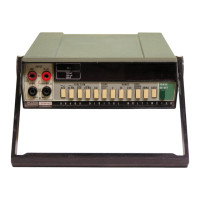8600A
3-42.
Control
and Display
343. The control
portion of the instrument
consists of
contacts
of the range
and function switches,
a three-pole-
double-throw
switch U16, a bipolar ROM
U9,
and
custom
integrated
circuit U8.
The
range
and function
switch posi-
tions
in conjunction with
strobe signal inputs
to U16, con-
trol the
illumination
of
the
polarity indicator on
the display
and
the
selection
of five or six ranges for
the autorange
feature. Refer
to Figure
8-1
for the
schematic diagram
of
the control circuits.
3-44
All timing and control information
is developed
in the DVM IC,
U8,
from
an
external clock consisting of
Y1 and U7.
Range
information
can be manually programed
by
the front panel range
and
function switches,
or auto-
matically programed by
U8.
Eight strobe signals (STO-
ST7) are developed in
U8 and
are used for range program-
ming
and display timing.
Digit information from the
counter is strobed
out in bed
format
on lines W,X,Y, and
Z (weighted
8,
4,
2,
and 1
respectively).
The strobe signals
are strobed sequentially
but
the
digit information pre-
sented on W,
X,
Y, and Z
is
interleaved. The
main signi-
ficant digit
(MSD) without polarity appears at
STO.
The
MSD with
polarity is presented at ST7. For the display,
either STO or
ST7 is
selected
by U16, which is programed
by
the function switches.
The second significant digit
(2SD)
appears
on W,
X,
Y,
and Z at ST2, the 3SD
at ST4,
the 4SD,
at ST6, and the 5SD
at
ST1
.
W,
X, Y, and Z pre-
sent
the digit information
to a
seven segment
decoder,
U10.
The strobe signals light the appropriate
display LED, U1
1-
U15,
through the
strobe drivers, Q29-Q39. The
decimal
point logic
(DPL)
from
U8 outputs a signal at the appro-
priate
strobe
signal.
For the lowest range
and the 20
range, lower
or
upper
annunciators will light.
ST signal (ST3
for the
20V range
etc.).
In autoranging
(3
is always connected
to
ST1 as the lower
limit
and a is
connected to ST5
(5
ranges) for
DCV and ACV
functions
and to
ST6
for the Ohms function.
3-46
For A/D Converter
timing all outputs (INT,
AZ,
DE(+R),
and
DE(-R)
)
from
U8
are
logic NOT outputs.
For example the INT output
(pin
40)
varies between OV
and
-15V.
During the integrate
signal pin 40 stops con-
ducting and goes to —15V, biasing the driver,
Q10,
off.
The gate of
Q14
goes to
—
2V allowing it to conduct. At
the end of the integrate
signal pin 40 conducts and goes
to
OV, biasing
Q10
on which drives the gate of
Q14
to
—15V, cutting
Q14
off.
The other control
signals
work
the same way
except that
the gates of the FETs go to OV
during their signal on times.
3-45
Range information outputs from U8 appear at a,
b,
and
c (pins
29,
28,
and
30)
which are weighted
4, 2,
and 1 respectively. The range information
is also
presented
on
W,
X,
Y,
and Z
at ST5
for the DOU output.
The
out-
puts at a,
b, and c are steady state outputs applied to
U9.
U9
interprets
the information and selects the
appropriate
relays.
Range truth tables are
included in table
4-12.
In
all cases the output
of U9 goes low to select a relay because
Relay
Common is connected to
+5V through S4A (DCmA).
Relay, Kl, is energized
only in
the
20V, 200V and 1200V
ranges of the
DCV function. Kl inserts the Input Divider
between
VS2 HI terminal
and
the A/D Converter.
The
lower two
ranges are applied directly to the
A/D
Converter.
In the lowest
range for all functions
U17 selects the .IV
reference
and
switches R66 into
the charge
path of
C28.
In range
programming
U8
the a input sets the upper
range
limit and the
|3
input sets the lower
limit.
Strobe signals
are
applied through
U16
and the
range
switches to
the
a
and
(3
inputs. For
manual range
programming
a and
j3
are tied together
by
U16. S6-S1
1 apply the appropriate
3-8 1/77

